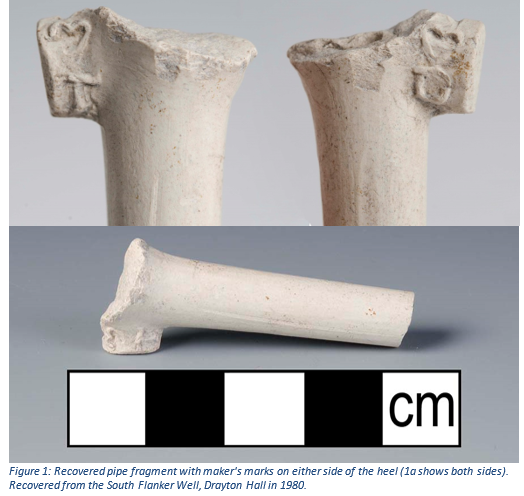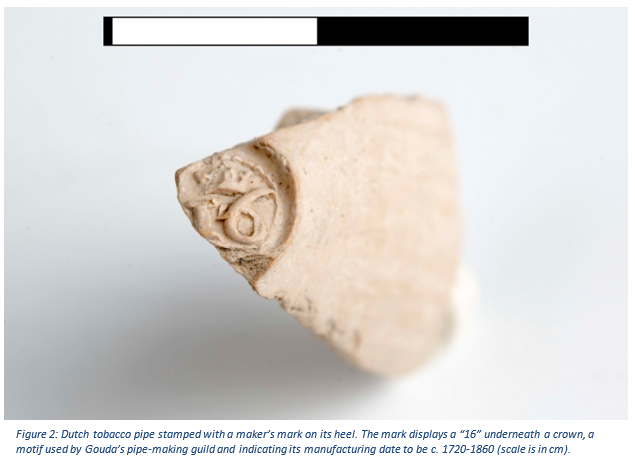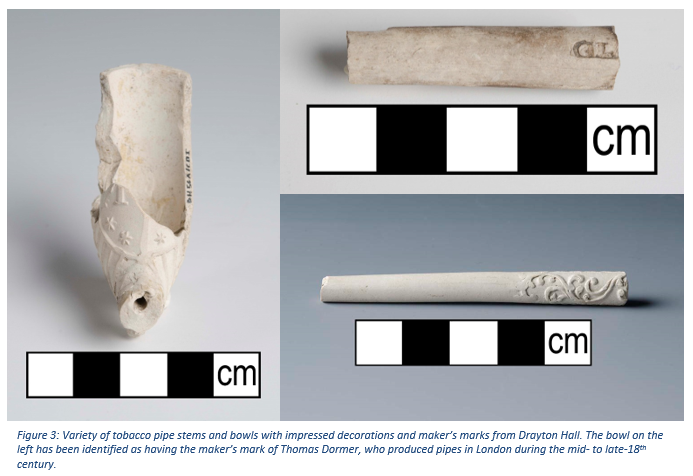Voted the Best Place to See by Condé Nast Traveler.

Last month, in the February 2020 edition of Circa, Drayton Hall’s monthly e-newsletter, we asked some of our Drayton Hall members whether they thought the symbol impressed on the pipe stem shown in Figure 1 was a heart or a crown. Perhaps it was in the spirit of Valentine’s Day, but the winning response was the heart!

In fact, interpreting these motifs correctly is important for accurately determining the origin and age of these tobacco pipes. Throughout the 17th – 19th centuries, European countries—predominately England—produced and traded these tobacco pipes to colonists and later Americans. Fortunately for historical archaeologists, these manufacturers recorded nearly everything about their business, including the specific motifs and maker’s marks they used and when.
For example, the pipe discussed above exhibits the initials “TO” on either side of the heel. This likely corresponds to “Thomas Owens,” a name which matches three different pipe makers in Bristol, England from the late-17th to mid-18th century. Currently, the presence of the adjacent motif—whether it be heart or crown—does not help narrow down this identification further.
That said, accompanying motifs can be very significant in determining place and time of origin. The pipe in figure 2 was impressed with a “16” underneath a crown (this one is undoubtedly a crown). According to several resources on Dutch tobacco pipes, this crown refers to the Gouda, NL pipe-making guild, which regulated the marks used during different time periods and by whom. This particular mark indicates that the Dutch pipe was made by one of eight possible manufacturers from the early-18th to mid-19th century.

Even if there is no mark visible on a pipe fragment—and this happens a lot considering how breakable these objects are—archaeologists can still employ a few other methods to determine the pipe’s age. For instance, bowl shapes have been noticed to change over time. Archaeologists like Ivor Noël Hume have used large assemblages of tobacco pipe bowls from historical sites (e.g. sites dating to after European contact in the U.S.) with known occupation dates to trace how the shape of these objects changed over time. This study was done so extensively that archaeologists can now determine a relatively narrow date range if they have enough of the tobacco pipe bowl present.
The other method for dating tobacco pipes involves measuring the bore (or cylindrical opening) on the inside of the pipe stem. Similar to the bowl shapes, the size of this bore changes steadily, becoming smaller over time. Archaeologists can now measure the bore size using drill bits to determine a reliable date range. Tobacco pipe stems are one of the most commonly recovered artifacts at historic sites, both because of the popularity in tobacco smoking and the highly fragmentary nature of the stem itself. As long as the bore remains intact, an archaeologist can determine a time period of manufacture.
At Drayton Hall, we study tobacco pipes in order to better understand not only associated date ranges of our site, but also the lives of the people working and living on the property. Maker’s marks provide insight into trade networks between Charleston and Europe, and their recovery across the landscape can shed light on the people moving across it. We continue to work with other institutions and archaeologists studying tobacco pipes in order to expand our knowledge of different types and their origins.

by Corey Ames Heyward, Wexler Curatorial Fellow in Archaeology